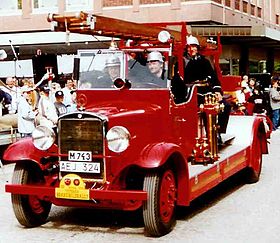Volvo LV66-series
| Volvo LV66-series | |
|---|---|
 | |
| Overview | |
| Manufacturer | Volvo |
| Production | 1931 - 1936, approx. 2,370 produced[1] |
| Body and chassis | |
| Class | Medium/heavy duty truck |
| Powertrain | |
| Engine | Volvo ohv inline 6 |
| Transmission | 4 speed non-syncro manual |
| Dimensions | |
| Wheelbase | 3.4 m (133.9 in) - 4.6 m (181.1 in)[1] |
| Curb weight | 6,000 kg (13,227.7 lb) - 9,500 kg (20,943.9 lb) (gross weight)[1] |
| Chronology | |
| Successor | Volvo Longnose |
The Volvo LV66-70 was a truck produced by Swedish automaker Volvo between 1931 and 1936.
History
Volvo introduced its first heavy truck in 1931. Unlike its smaller sibling, who used some elements from Volvo’s passenger cars, the LV66-series components were built exclusively for truck use.[2] These included a new overhead valve engine, a heavy duty four-speed gear box, steel rims and four-wheel hydraulic brakes.
The truck was built in two weight classes: the smaller LV68 and LV69 with a payload of 3.25 tonnes and the heavier LV66 and LV67 with a payload of 3.5 tonnes. From 1933 the LV66 and LV67 could be delivered with a trailing axle which increased the payload to 5.25 tonnes. The long wheelbase LV70 was primarily equipped with bus bodies.[2]
From 1933 the LV66-series were sold with a Hesselman engine as an alternative.
Engines
| Model | Year | Engine[1] | Displacement | Power | Type |
|---|---|---|---|---|---|
| LV66-70 | 1931-36 | Volvo DC: I6 ohv | 4,097 cc (250.0 cu in) | 75 bhp (56 kW) | Petrol engine |
| LV66-70 | 1933-36 | Volvo HA: I6 ohv | 4,097 cc (250.0 cu in) | 75 bhp (56 kW) | Hesselman engine |
References
- ^ a b c d Olsson, Christer (1987). Volvo - Lastbilarna igår och idag. Malmö, Sweden: Förlagshuset Norden AB. ISBN 91-86442-76-7.
- ^ a b Volvo Trucks Global - history
